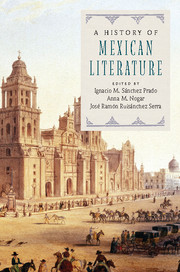Book contents
- Frontmatter
- Contents
- List of contributors
- Introduction
- PART I COLONIAL LITERATURE
- 1 The Languages and Literatures of Early Print Culture in the Colonia
- 2 A Chronicon of Crónicas: The New Spanish Prose Narrative
- 3 Theatricality and the Public Enactment of the Mexican Colonial
- 4 Sor Juana Inés de la Cruz: The Tenth Muse and the Difficult Freedom to Be
- 5 Jesuit Enlightenment: Interventions in Christianity and Intellectualism
- 6 Women in the Print Culture of New Spain
- 7 The Colonial Literary Scope: Empire, Letter, and Power
- 8 New Spain's Archival Past and Present Materiality
- PART II THE NINETEENTH CENTURY
- PART III TWENTIETH AND TWENTY-FIRST CENTURIES
- PART IV MEXICAN LITERATURE BEYOND BOUNDARIES
- Index
- References
3 - Theatricality and the Public Enactment of the Mexican Colonial
from PART I - COLONIAL LITERATURE
Published online by Cambridge University Press: 05 July 2016
- Frontmatter
- Contents
- List of contributors
- Introduction
- PART I COLONIAL LITERATURE
- 1 The Languages and Literatures of Early Print Culture in the Colonia
- 2 A Chronicon of Crónicas: The New Spanish Prose Narrative
- 3 Theatricality and the Public Enactment of the Mexican Colonial
- 4 Sor Juana Inés de la Cruz: The Tenth Muse and the Difficult Freedom to Be
- 5 Jesuit Enlightenment: Interventions in Christianity and Intellectualism
- 6 Women in the Print Culture of New Spain
- 7 The Colonial Literary Scope: Empire, Letter, and Power
- 8 New Spain's Archival Past and Present Materiality
- PART II THE NINETEENTH CENTURY
- PART III TWENTIETH AND TWENTY-FIRST CENTURIES
- PART IV MEXICAN LITERATURE BEYOND BOUNDARIES
- Index
- References
Summary
Every performance enacts a theory and every theory performs in the public sphere.
—Diana TaylorThe history of theater and performance in colonial Mexico is especially rich, given the area's cultural heterogeneity, legacy of performance culture, and linguistic variety. Spaces for performance were also surprisingly numerous, including public plazas, open chapels, and traditional theater spaces. It is for this reason that one must view colonial Mexican theater as a unique form of cultural production that reimagined public space, cultural identity, and early modern Spanish theatrical forms.
Mexican theater histories usually open with the 1533 production of El juicio final, a Christian missionary play in Nahuatl first staged in Tlatelolco. But Mexican performance history begins much earlier, with indigenous rituals and secular enactments that predate the conquest; these include mitotes (dances), macehualitzli (sacred dances), netotilizli (social dances), narrative songs, musical performances, and human and animal sacrifices with performative aspects (Sten, 1990; Taylor, 2003; Scolieri, 2013). There was also a rich indigenous musical culture that the missionaries later incorporated into Christian worship practices (Truitt, 2010). Scholars do not know much about these forms other than what missionary chronicles written after the Spanish Conquest – such as Diego Durán's Historia de las Indias de Nueva España y islas de Tierra Firme (1581) and Bernardino de Sahagún's La historia universal de las cosas de Nueva España (1590) – record. A common thread in their descriptions is that many of the ceremonies, which usually included song and dance, were put on for large audiences in public spaces such as temples and plazas, as well as at lords’ houses (Sten, 1990: 64).
Used to regenerate sacred cosmological processes and to underscore the power of certain indigenous leaders, these sacred performance forms do not fall easily within the rubrics of mimesis particular to contemporary Western theater or their contemporaneous allegorical forms from medieval and early modern Spain. The human “representation” of Aztec deities by ixipitlas (humans), for example, involved the sacrifice of slaves or captured warriors that represented the gods and were then killed, after which priests integrated their remains into ritual choreographies (Scolieri, 2013: 57). Understanding the meaning of these dances is virtually impossible, because the Catholic priests concentrated on the details they found disturbing without reference to the indigenous cosmologies that informed them.
- Type
- Chapter
- Information
- A History of Mexican Literature , pp. 53 - 65Publisher: Cambridge University PressPrint publication year: 2016



